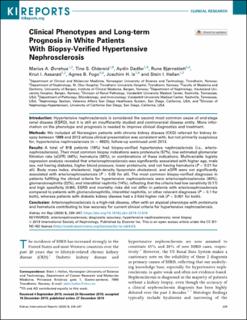| dc.description.abstract | Introduction
Hypertensive nephrosclerosis is considered the second most common cause of end-stage renal disease (ESRD), but it is still an insufficiently studied and controversial disease entity. More information on the phenotype and prognosis is needed to improve clinical diagnostics and treatment.
Methods
We included all Norwegian patients with chronic kidney disease (CKD) referred for kidney biopsy between 1988 and 2012 whose clinical presentation was consistent with, but not primarily suspicious for, hypertensive nephrosclerosis (n = 4920); follow-up continued until 2013.
Results
A total of 918 patients (19%) had biopsy-verified hypertensive nephrosclerosis (i.e., arterionephrosclerosis). Their most common biopsy indications were proteinuria (57%), low estimated glomerular filtration rate (eGFR) (44%), hematuria (34%), or combinations of these indications. Multivariable logistic regression analysis revealed that arterionephrosclerosis was significantly associated with higher age, male sex, not having diabetes, higher blood pressure, lower proteinuria, and not having hematuria (P < 0.01 for all). Body mass index, cholesterol, high-density lipoprotein cholesterol, and eGFR were not significantly associated with arterionephrosclerosis (P > 0.05 for all). The most common biopsy-verified diagnoses in patients fulfilling the clinical criteria for hypertensive nephrosclerosis were arterionephrosclerosis (40%), glomerulonephritis (22%), and interstitial nephritis (14%), reflecting that the criteria had low sensitivity (0.17) and high specificity (0.94). ESRD and mortality risks did not differ in patients with arterionephrosclerosis compared to patients with glomerulonephritis, interstitial nephritis, or other relevant diagnoses (P > 0.1 for both), whereas patients with diabetic kidney disease had a 2-fold higher risk (P < 0.001 for both).
Conclusion
Arterionephrosclerosis is a high-risk disease, often with an atypical phenotype with proteinuria and hematuria contributing to low accuracy for current clinical criteria for hypertensive nephrosclerosis. | en_US |

